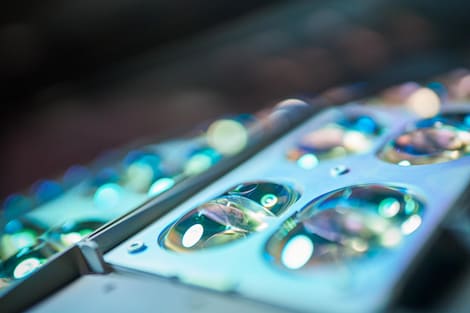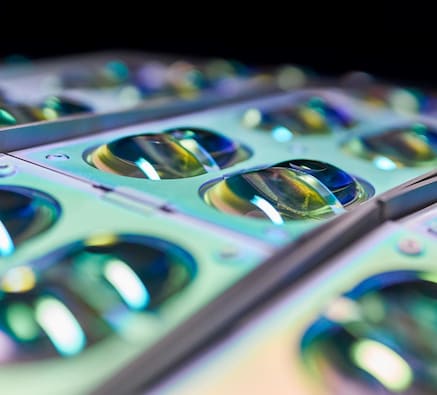- Smart Manufacturing
- Tech Talk
From design to manufacturing: What to consider when designing optical components for injection molding
Learn how to design polymer optics for injection molding – with practical guidelines from our expert Dr. Florian Tomiak on gates, inserts, draft angles and more.

The demand for high-performance polymer-based optical components continues to grow – particularly in fields such as medical technology, sensing, augmented reality and virtual reality (AR/VR) as well as illumination. Polymer optics offer clear advantages: they’re lightweight, cost-efficient and allow a high freedom of design. Yet, the design freedom requires a solid understanding of manufacturing constraints.
How can optical components be designed for precise, reproducible and scalable production through injection molding? And what role do gate placement, ejectors or draft angles play in that process?
In this interview, Dr. Florian Tomiak, a senior expert in polymer optics manufacturing at Jenoptik, shares his insights on translating design into production – and explains why early coordination between design and tooling is key to success.
Thank you for taking the time to speak with us, Dr. Tomiak, to share your experiences and expertise in the field of polymer optics. Dr. Tomiak, what are the main differences between designing polymer optics and glass optics?
Dr. Tomiak: Generally, there are many aspects differing between polymer and glass optics. Today, I would like to focus on key differences in the manufacturing process. While glass optics are typically shaped through grinding, polishing, or pressing, polymer optics are typically produced using injection molding – a process more comparable to casting. That opens a far greater design freedom for polymer optics, particularly when it comes to complex geometries or integrating additional functional elements.
So, you're able to combine multiple functions in a single component?
Exactly. With polymer optics, we can integrate not just optical but also mechanical or even electronic functions directly – like mounting features, housings, film hinges and many more. But this creative freedom comes with a caveat: what works in design must also be viable in production.
What are the most important design factors to ensure a smooth manufacturing process?
One of the most critical elements is the gate – that’s the injection point where the molten polymer enters the mold. If it’s placed incorrectly, you’ll get internal stresses or optical defects where you don’t want it. That’s why the gate zone must be considered right from the start – ideally in non-optical or optically not relevant areas.
That sounds like something that could be easily overlooked. Are there other sensitive points?
Definitely. Take the ejectors, for example – small pins that push the part out of the mold. If they touch active optical surfaces, they’ll leave marks or cause deformations. And then you have the so-called draft angles – slight tapers on the side walls that make it easier to release the part from the mold.
So, a bit like getting ice cubes out of a tray – without the taper, they just get stuck?
Exactly! That’s a great comparison. A part with perfectly vertical walls gets stuck and deforms on release. A draft of just 1 to 3 degrees allows the part to slide out cleanly – saving time, cost and scrap.

What do designers need to consider when it comes to optical inserts?
Inserts are the tool elements that define the optical surfaces inside the mold. They need to be extremely precise – that’s why we rely on ultra-precision machining with diamond tools, followed by a polishing step.
What are the typical limitations in that process?
One of the main challenges are sharp edges. The sharper the geometry, the higher the risk of cracking. Those areas also tend to cause surface gradients or optical imperfections. So, we usually recommend keeping the clear aperture slightly smaller than the insert diameter and adding a minimal edge radius. For some applications, such as Fresnel structures, sharp edges are very important to the optical design & performance. We have tools and a lot of experience to realize sharp inner and outer edges but explaining that would probably go beyond the scope of this interview.

What happens if the material flow inside the mold isn't properly controlled – for example, with weld lines?
When the polymer is injected and flows through multiple paths inside the mold or the mold flow is spitted due to certain geometrical structures, it may reunite at some point. Where two flow fronts meet, a so-called weld line can occur – a visible seam that’s especially noticeable under certain lighting conditions.
And these seams actually affect optical quality?
Absolutely. These areas are prone to internal stresses and anisotropic molecular orientations, which can lead to distortion, birefringence, or unwanted light scattering. One possible way to avoid that is through injection compression molding – where the polymer is injected into a partially open mold and then compressed. This prevents flow collisions and creates a more homogeneous part. However, the success of this strategy largely depends on individual geometrical circumstances.


What are some common design pitfalls – and how can they be avoided?
We often see designs that look perfect at first glance – optically and functionally. But on closer inspection, you notice that certain surfaces are too close to parting lines, or ejector positions end up on critical optical areas.
So, these are issues that can be avoided with earlier coordination?
Exactly. Many of these potential stumbling blocks can be addressed early if design and manufacturing go hand in hand. It saves time, cost, and brings products to market faster. And honestly – it’s just more rewarding when you develop good solutions together.

To put this into context – could you share a typical example of how this coordination plays out in a real project?
Of course. In a medical technology project, we were working on a very compact optical system with high imaging precision and extremely limited installation space. The initial optical design looked great on paper – but it left almost no room for ideal gate and ejector placement. This wasn’t obvious at first in CAD but became critical during simulation and tooling design.
Together with the client, we made a minor adjustment: we kept the optical function intact, but slightly shifted the parting line and optimized the draft angle. The result? The part could be produced reliably and cost-effectively. The prototype worked right away – and the series production ran virtually error-free.
Experiences like that remind me how much smoother things run when everyone gets involved early – from both design and production.
I can see that – and it’s probably one of those things you only really appreciate once you've seen what a difference it makes.

Before we wrap up, we’ve got three quick closing questions for you – short and spontaneous. A tool or technique you wouldn’t want to work without?
Ultra-precision turning with diamond tools. [see image]
What surprises clients most in their first joint project?
How much the design impacts production quality – and how early manufacturing should be involved.
Where do you see the greatest potential for polymer optics in the coming years?
Compact sensor systems with integrated optics – especially for medical, mobile and connected applications.
Dr. Tomiak, thank you so much for your time – and for sharing such insightful and practical perspectives.
Thank you – I always appreciate these conversations. They’re a great opportunity to share knowledge and ideas for new solutions.
Jenoptik – Your partner for precision polymer optics

Jenoptik develops and manufactures high-precision optical systems made from polymer – from initial concept to high-volume production. With over 40 years of experience, in-house tooling capabilities and highly automated processes, we deliver customized solutions for medical technology, sensing, industrial optics, AR/VR and more.
Are you planning a project involving polymer-based optical components?
Get in touch – our experts are here to support you from concept to series production.








